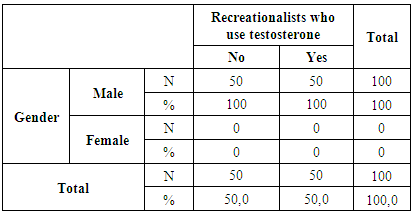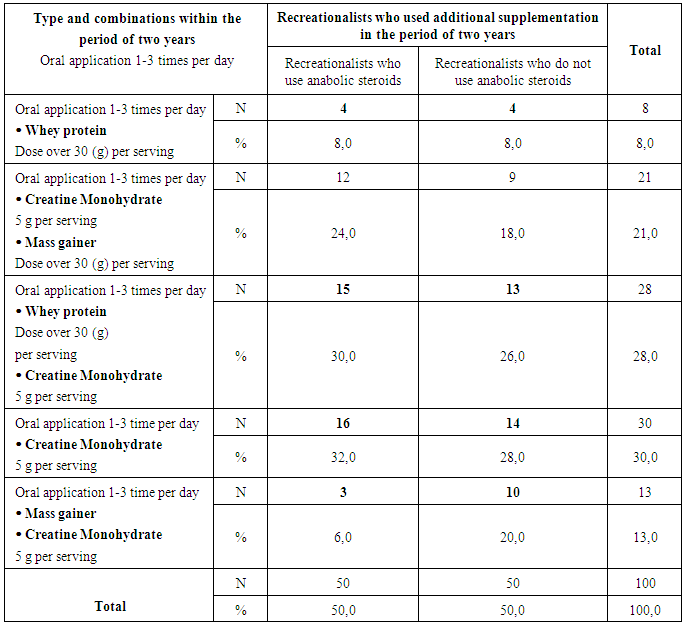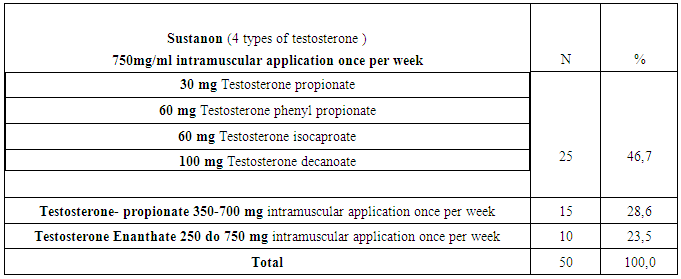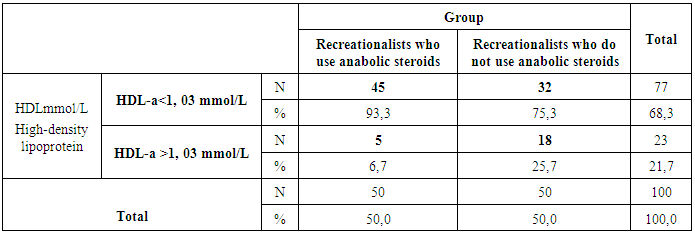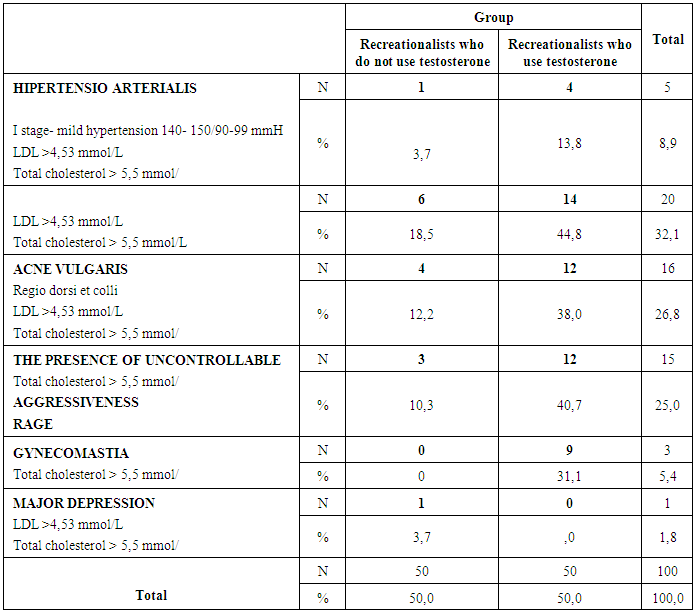-
Paper Information
- Next Paper
- Paper Submission
-
Journal Information
- About This Journal
- Editorial Board
- Current Issue
- Archive
- Author Guidelines
- Contact Us
International Journal of Sports Science
p-ISSN: 2169-8759 e-ISSN: 2169-8791
2016; 6(6): 230-236
doi:10.5923/j.sports.20160606.05

Irrational Abuse of Testosterone and Mass Supplements by Recreational Bodybuilders with “Adonis Complex” Leads to Potential Cardiovascular Diseases and Psychophysical Disorders
Sid Solakovic1, Mensur Vrcic2, Nina Solakovic3, Ratko Pavlovic4
1Clinic for Vascular Surgery, Clinical Center of University of Sarajevo, Sarajevo, Bosnia and Herzegovina
2Faculty of Sport and Physical Education, University of Sarajevo, Sarajevo, Bosnia and Herzegovina
3Clinic for Dermatology, Clinical Center of University of Sarajevo, Sarajevo, Bosnia and Herzegovina
4Faculty of Physical Education and Sport, University of East Sarajevo, East Sarajevo, Bosnia Herzegovina
Correspondence to: Ratko Pavlovic, Faculty of Physical Education and Sport, University of East Sarajevo, East Sarajevo, Bosnia Herzegovina.
| Email: |  |
Copyright © 2016 Scientific & Academic Publishing. All Rights Reserved.
This work is licensed under the Creative Commons Attribution International License (CC BY).
http://creativecommons.org/licenses/by/4.0/

Introduction: Knowledge leakage about potential Testosterone side effects on mental and physical condition is present in many young recreational bodybuilders in Bosnia and Herzegovina between 18 and 25 years of age, who have no motivation to compete and who suffer from the Muscle dysmorphia Adonis Complex. Risk factors such as aggression behaviour, acne vulgaris, gynecomastia, arterial hypertension and increasing lipid levels represent major side effects. Some risk factors such as arterial hypertension and increased lipid levels play important role in the pathogenicity of Testosterone when combined with Mass Supplements. These risk factors are responsible for the occurrence of permanent cardiovascular damage in young recreational bodybuilders. Objective: The aim of the study was to estimate the side effects of abusing testosterone in young recreational bodybuilders who have no motivation to compete. This Study will try to estimate and analyse the influence of testosterone side effects on vascular status HDL/LDL (High-density lipoprotein/Low-density lipoprotein serum lipid) levels, aggression behaviour, presence of acne vulgaris, gynecomastia, and arterial hypertension in young recreational bodybuilders aged between 18 and 25 in Bosnia and Herzegovina after a 2 year research. Methods: The prospective study included 100 individuals included in the recreational exercising programme in the period between July 2014 and July 2016. 50 individuals abusing testosterone during the 2 year period were compared with 50 individuals who were not abusing testosterone. Non-invasive methods were used in all individuals (clinical examination and laboratory tests of lipid levels). The routine of anaerobic weight training units in the Gym for both groups was 1,5 – 3,5 hours, 4-6 times per week. Results: Final analysis has revealed that statistically dominant population of young testosterone drug abusers are males (100%) or 50 individuals. Analysis has revealed that the testosterone abuse group have increased levels of LDL lipid serum when compared with the other group and it is the most dominant side effect. HDL (High-density lipoprotein) levels under 1,03 mmol/L were more present in Testosterone abuser group in 45 individuals or (93,3%) and was statistically considered significant (p<0,05). Conclusions: Recreational male bodybuilders between 18 and 25 years of age are dominant testosterone abusers, trying to achieve better muscle proportion and physical performance neglecting the testosterone side effects. We could not prove health benefits from increased serum and for young recreational bodybuilders one of the serious health consequence of using testosterone during recreational exercising programme were the devastating LDL lipid levels which is also connected with the development of arterial hypertension and hyperlipidaemia progressing the pathogenicity of cardiovascular disease followed by devastating health disorders. The benefits of anaerobic weight training for those who abused testosterone in regards to their cardiovascular safety have not been confirmed.
Keywords: Testosterone, Recreational bodybuilders, Arterial hypertension, Hyperlipidaemia, Lipid profiles (HDL/LDL), Acne vulgaris, Aggression behaviour
Cite this paper: Sid Solakovic, Mensur Vrcic, Nina Solakovic, Ratko Pavlovic, Irrational Abuse of Testosterone and Mass Supplements by Recreational Bodybuilders with “Adonis Complex” Leads to Potential Cardiovascular Diseases and Psychophysical Disorders, International Journal of Sports Science, Vol. 6 No. 6, 2016, pp. 230-236. doi: 10.5923/j.sports.20160606.05.
Article Outline
1. Introduction
- Knowledge leakage about potential Testosterone side effects on mental and physical condition is present in many young recreational bodybuilders in Bosnia and Herzegovina between 18 and 25 years of age, who have no motivation to compete and who suffer from the Muscle dysmorphia "Adonis Complex". Risk factors such as aggression behaviour, acne vulgaris, gynecomastia, arterial hypertension and increasing lipid levels represent major side effects. Some risk factors such as arterial hypertension and increased lipid levels play important role in the pathogenicity of Testosterone when combined with Mass Supplements. These risk factors are responsible for the occurrence of permanent cardiovascular damage in young recreational bodybuilders. Testosterone is one of the most abused, most attractive and most effective doping substances in young athletes in elite and recreational sport. The epidemic of steroids’ misuse in application, which includes testosterone in fitness clubs in Bosnia and Herzegovina is getting more attractive and is more applicable as an alternative and sometimes as a desperate method to achieve better physical performance in as much shorter time as possible, and to develop the subjective perspective of strength increase with developing an objective perspective of body mass increase. All of this leaves a trace and the price of the success surpasses the harmless and irrational Adonis complex into an occurrence of life threatening irreversible symptoms of cardiovascular diseases [1, 2]. According to a number of studies, the subjects who have for a longer number of years abused testosterone had experienced a similar anabolic effect as synthetic anabolic steroids (Dianabol/Deca –Durabolin) resulting in a symmetric muscle hypertrophy followed by excellent improvement in physical performances, as well as the side effects of decreased erectile function and testicular atrophy in the group of male population who exhibited long-term changes over a significant period of time [3, 4]. In today’s surrounding, synthetic derivatives of testosterone (Cypionate, Enanthate, Acetate, Propionate) which are usually used in combination with other anabolic steroids have quickly found their way within the young elite athlete population, young recreational bodybuilders, resulting in sequences of dramatically increased energy levels and increased muscle mass, without being aware of behavioural changes, and the potential cardiovascular system deterioration. Apart from diabetes mellitus as one of the risk factors for developing cardiovascular diseases, arterial hypertension with hyperlipidaemia represent key risk factors in the progress of cardiovascular pathogenesis [5, 6]. The studies, which affirm the presence of arterial hypertension in young recreationalists without exhibiting any signs of clinical symptoms, have been confirmed. Likewise, a number of studies were noted confirming the increase of systolic blood pressure over 10 mmHg after a three month application of anabolic steroids (Kuipers study) over the period of one year [5]. Hartagens negates the increase of blood pressure in patients who have used anabolic steroids in combination, therefore further studies are necessary in order to confirm that fact [7, 8]. The increase in the overall level of cholesterol with a decreased HDL (High-density lipoprotein) and an increased LDL (Low-density lipoprotein) contributes to the pathogenesis of accelerated arteriosclerosis and the very development of a clinical asymptomatic and symptomatic cardiovascular disease [8-10]. Singh provides proof that continuous intramuscular application of 600mg/testosterone cypionate per week significantly reduces the level of HDL in the serum, while short term application (up to 2 months) do not have any effect on the reduction of HDL level. However, there is a lack of studies dealing with a long-term continuous testosterone application, and the effects on the obtained lipid laboratory results regarding the development of potential cardiovascular disease pathology. The moment the application of testosterone cypionate and other anabolic steroids has ceased, great number of cycles in combination with a new remodelled diet, which can last up to a couple of months, may take place in order to achieve referential values in laboratory tests for HDL. However, due to the lack of studies which deal in that topic, we cannot with certainty correctly project the aforementioned facts [10, 11]. Also, one of the leading side effects of the anabolic steroids application is the acne vulgaris (steroid acne). The dermatology study: Bodo Melnik and co-authors: “The abuse of anabolic-androgenic steroids and bodybuilding acne”, indicates the presence of acne in over 50% of recreationalists aged between 18 and 26 who have used steroids. The study confirms that every other subject has exhibited presence of acne. Gynaecomastia is usually exhibited as a misbalance of hormones in the male breast tissue and is the main occurrence in athletes who misuse anabolic steroids, and are usually present in athletes with a different degree of manifestation in gynecomastia clinical testing [11-13]. De Luis DA and co-authors in their study: “Anabolic steroids and Gynaecomastia” prove that even 52% of subjects who have used anabolic steroids for a longer time exhibit the presence of Gynaecomastia. From the aspect of health, a question is imposed concerning the effects of continuous irrational cycles of testosterone application on a young, scientifically oblivious healthy population of recreational bodybuilders aged between 18 and 25, who have no motivation to compete and no history of diseases (asymptomatic clinical status without a history of diseases and with their lipid levels within referential values), and what would be a benefit of physical anaerobic activities such as weight lifting on health and body. Likewise, it would be noteworthy to question the amount of damage on vascular system as a result of a two year continuous cycle abuse including an insufficient and sub dosed cleaning period of 2 to 3 months per year in certain B&H Gyms. The most common social behaviour deviations caused by an increased level of testosterone are the possibility of exhibiting depression and aggressiveness. Likewise, the main cause of depression which is followed by an increased level of testosterone is a hormonal misbalance, due to which young athletes who have an increased level of testosterone usually in critical situations behave overly impulsive and aggressive. As an extra supplementation in the attempt to increase volume of their muscle mass and subjective strength, Creatine Monohydrate, High - Carb Whey Protein and other types of mass gainers are used [14, 15]. Mass gainer is a high calorie carbohydrate, and its benefit for recreationalists, those that wish to consume a greater amount of calories, is to improve their muscle mass, which is precisely why most of those who decide to consume gainers gain most of the useless (fat) tissue that can result in the increase of systolic and diastolic arterial blood pressure as well as an increase in lipid blood values [16, 17].
2. Patients and Research Methods
- The research encompasses prospective study within the period from June 2014 to June 2016, including 100 subjects aged between 18 and 25, who have likewise been involved in recreational anaerobic fitness programme (weight lifting and/or use of gym machines for individual and systematic muscle groups with maximum and sub maximum repetitions) from 1,5 to 3,5 hours for 4-6 times per week without, any motivation to compete, and within the training concept aimed at achieving subjective muscle mass and muscle strength. In all the subjects no instances of coagulopathy, haemophilia, diabetes mellitus type I and II, malignancy or any other type of cardiovascular disease were noted. All subjects before study have normal blood lipid levels ( HDL 1,03-1,55 mmol/L and LDL 1,55-4,53 mmol/L and overall cholesterol level 3,10-5,5 mmol/L), no clinical evidence of Hypertension (120 mm Hg or less Systolic Pressure and 80 mm Hg or less Diastolic Pressure by the American Heart Association hypertension guidelines). Individual Subjects were excluded from the study if they had the following: myocardial infarction or coronary revascularization, peripheral vascular surgery or percutaneous intervention procedure within 12 months, unstable angina within the previous 12 months, stroke or transient ischemic attack within 12 months, deep venous thrombosis within 12 months or chronic or acute liver disease within the previous 12 months before study. The body mass index (BMI) in the all 100 subjects were between 19 and 27 (mean BMI was 23,7 for both groups), also all the 100 subjects are white-skinned (Light-skinned). The diet in all the subjects was based on free diet concept, which likewise includes traditional national Bosnian fast food (ćevapćići–grilled minced meat / pies) with the free use of nutritive supplements of their own choosing (Whey protein/ Creatine monohydrate/ mass gainers) as an everyday diet regardless of basic metabolism and calorie intake record. Lipid and vascular status within the group comprised of 100 subjects will be compared, out of which group A (50 subjects with blood lipid levels HDL levels <1,03 or >1,03 mmol/L, LDL levels >4,53 mmol/L and overall cholesterol levels >5,5mmol/) used synthetic testosterone for 5 years with the cleansing period of 2 to 3 months each year and group B (50 subjects with blood lipid levels, HDL levels <1,03 or >1,03 mmol/L,LDL levels >4,53 mmol/L and overall cholesterol levels >5,5mmol/) who have never used synthetic testosterone. The results will be processed using the standard statistical programme, and presented via tables and graphs, the p value smaller then (p<0,05) will be taken as a measure of statistical significance. All the patients prior to the study did not exhibit the increased blood pressure and their lipid status was within referential values. Likewise, prior to conducting the study, the aggressive and uncontrollable behaviour along with depression, gynecomastia, hypogonadism and acne vulgaris was not noted. Informative conversation was held with all the subjects, and with each subject consent form was signed regarding the potential health violations, and confirmed cardiovascular damage, therefore prior to self-initiated application each subject was familiarized and informed on potential side effects of testosterone, as well as mental and physical health benefits of the training. This study attempts at obtaining medical and laboratory parameters in subjects aged from 18 to 25 (mean age was 22,3 for both groups) who irrationally apply testosterone intra muscularly in various chemical forms, 2 to 3 times per week with additional supplementation (whey protein/Creatine/mass gainer). Likewise, the aim is to obtain a medical and social insight into the health and mental status of an individual, and to use the gained data to point towards the seriousness of fatal damage on cardiovascular and psychological system of an individual, as well as to try to improve or alter the guidelines of preventive measures as a part of a culture of living, and to avoid potential permanent cardiovascular disability.
|
3. Results
- By the statistical analysis of the group of subjects who have used testosterone intramuscularly over two years, the results of the most common combination of testosterone application side effects were obtained, and the presence of mild hypertension was significantly confirmed (arterial prehypertension status) (140-159/90-99mmH) and hyperlipidaemia (test results of increased LDL >4,53mmol/L, as well as an increase in overall cholesterol >5,5 mmol/L) in (13,8%) or 4 subjects, as opposed to (3,7%) or 1 subject. Test results of increased LDL >4,53 mmol/L were recorded in (44,8%) of cases or in 14 subjects within the group of subjects who used testosterone as opposed to the group of 6 subjects or (18,5%) who have not used testosterone, thus noting statistically significant difference between the groups (p>0,05). Locating Acne Vulgaris on back and neck in combination with increased test results of LDL >4,53 mmol/L have been significantly recorded in 12 subjects (38,0%) who have used testosterone (p>0,05). Likewise the presence of subjective aggressiveness followed by rage attacks, and the level of overall cholesterol >5,5mmol/L accompanied by acne vulgaris has been noted in 12 subjects or (40,7%) as opposed to the group who have not used testosterone, that is just 3 subjects (10,3). The lowest recorded level of major depression with the level of overall cholesterol > 5,5mmol/ was noted in 1 subject (3,7%) belonging to the group of subjects who have not used testosterone within the two year study. Combination of gynecomastia and the level of overall cholesterol >5,5mmol/ was noted in 9 subjects or (31,1%) within the group who have been using testosterone intramuscularly over the two year study period, exhibiting a statistically significant difference between the groups (p<0,05). The most frequently used supplements by all the subjects were the combinations of Whey Protein and Creatine Monohydrate, regardless of whether or not they used testosterone.
|
|
|
4. Discussion
- Based on the results of this study, the effects of traditional Bosnian diet in combination with testosterone, without keeping record on basic metabolism and calorie intake, lead to dramatic decrease in the values of HDL and an increase in LDL values, which represents a shocking information for young active recreationalists aged between 18 and 25 who are aiming at developing greater muscle performance. In a group of subjects of recreational bodybuilders the analysis of gender representation has documented a statistically significant data regarding the male subjects who have used testosterone in (100%) of cases or 30 subjects, explaining its ever growing use within male population. The conducted research indicates that the subjects who have used testosterone as a part of their regular fitness programme without any motivation to compete, within the two year period, exhibit statistically significant increase of systolic and diastolic blood pressure values (first stage of hypertension) in combination with increased blood lipid values as opposed to the subjects who have not used testosterone which is also confirmed by Yeater, Reed, Ullrich et al. [18]. In further analysis the most frequent and most favourable testosterone compound in black market were evaluated. Three testosterone compounds were recognised as the most favourable among the population of recreationalists between 18 and 25 years of age, dominated with a statistically significant difference. Sustanon is the most favourable testosterone compound in recreationalists and it is mostly present in the analysis of 25 subjects or (46,7%) (p>0,05). It was discovered that Sustanon’s price varies from 35 to 40 Euros in B&H black market, and that is it very sought after and popular in younger recreationalists. Is it due to its affordable price, manipulation of the very facts concerning its effect on health and in achieving muscle strength and muscle mass, or maybe it is due to the good sale marketing, additional studies are required to get clear results and scientific confirmation. The second most favourable in 15 subjects or (28,6%) is Testosterone Propionate, and the least favourable is Etanat used by 10 subjects or (23,5%). After a two year research, we have analysed lipid and vascular status in bodybuilding recreationalists aged between 18 and 25 regardless whether or not they used testosterone. The presence of aggressive outbreaks during and after training has been more dominant in subjects who have used testosterone then in subjects who have not used it in two years. Aggressive behaviour was followed by an increase in overall >5,5 mmol/L cholesterol in 12 or 40,7% of subjects (p>0,05). The statistical analysis performed in the group of subjects who have used testosterone has significantly confirmed high values of LDL>4,53mmol/L and overall cholesterol >5,5mmol/L in (44,8,%) in 14 subjects as opposed to (18,5%) or 6 subjects, which favours ever growing progression of risk factors leading to cardiovascular diseases (p>0,05). Likewise, the low level of HDL has been recorded in 93,3% or 45 subjects who have used anabolic steroids in combination with testosterone which favours the study conducted by Taggart and co-authors (p>0,05) [19]. A free choice in the amount and calorie intake of traditional food (high fat, high calorie and low nutrition food) is likewise one of the crucial factors leading to a great decrease in the values of HDL which goes below 1,03mmol/L. The presence of Acne Vulgaris has been noted in 12 subjects or (38%) compared to 4 subjects (12,2%), as well as the presence of gynecomastia which was noted in 9 subjects or (31%) with an increased values of overall cholesterol, which is a significantly more common side effect in recreationalists who have used testosterone (p>0,05). The signs of depression were not noted in significant values in both groups of subjects. Via result tests of lipid status and increased arterial blood pressure, it has been confirmed that bodybuilding recreationalists involved in anaerobic programme training aged between 18 and 25 who have used testosterone during their training, fall within a risk group exhibiting a great increase in possibilities of suffering from cardiovascular diseases. Concerning the therapy misuse of testosterone in recreationalists, there is a great void due to lack of information. The study “Cardiovascular alterations associated with doping” conducted by authors Büttner A. and co-authors claims that great doses of anabolic steroids have caused considerable damage on cardiovascular system, without any additional information on testosterone application [20]. Whey protein combined with Creatine Monohydrate is likewise one of the most commonly used compounds in both groups of subjects, in 15 subjects using testosterone and 13 subjects not using testosterone. Also, the lack of nutritive components in the traditional Bosnian food represents, for the most part an everyday diet of an individual due to its low prices and good taste, and is responsible for the great increase in hyperlipidaemia in our country. 100 grams of zeljanica (of pie with spinach) has 207 calories. These calories come from 29 grams of carbohydrates, 9 grams of protein and about 6-7 grams of fat, while 100 grams of burek (pie with meat) on average contains around 291kcal: protein: 7,9 carbohydrates: 41,06 fat: 10,53 (a portion of 10 ćevapi with 200 grams of bread contain 910 calories). As an additional supplementation Whey protein which within 100 grams contains around 18gr of carbohydrates, (12 grams of sugar) and 70 grams of protein additionally increases the irrational calorie intake in recreationalists. Whey protein’s origin is primarily young cheese (milk product) and should not affect the increase in cholesterol level. Our study has confirmed that Whey protein, Creatine and Mass Gainer in combination with Bosnian traditional fast food raise the level of overall cholesterol and LDL, and to a lesser extent lower the level of HDL within those subjects who have not used testosterone as opposed to those who have. However, the extent of its effect by the end of the study are quite enough to lead to a prescription of Statin by internal medicine or angelology doctors for the treatment of cardiovascular diseases, aimed at lowering the cholesterol level and accompanied by a specific diet regime. Zhang (2016) in his study from 2016 entitled “Effect of whey protein on blood lipid profiles” indicates that the use of Whey protein has no side/effects on the lipid status and does not raise the cholesterol level, LDL level and that it does not affect the decrease of HDL level [21]. Our research team, in consultations with doctors of internal medicine believe that these testosterone application cycles in combination with traditional national Bosnian fast food and additional application of high calories supplementation directly worsen the health of an individual, and that the younger generations, who are too occupied with their subjective image of strength, should be paid additional attention to in order to divert their attention to the absurdity of the very concept of such training and endangering their own health.
5. Conclusions
- It is unthinkable as to what amount of damage to vascular system can be inflicted by irrational misuse of testosterone application in sport recreationalists, as well as the uncontrollable calories intake of each recreationalist. The analysis of a two year study favours the intensity acceleration of the pathogenesis of arteriosclerosis without any signs of protective benefit of the training on the very cardiovascular system, which leads to coronary or vascular incident or potential revascularization. The later potential cardiovascular diseases, due to the continuation of this type of irrational training and the bad health effects of doping, we cannot elaborate further nor confirm statistically from the context of this research, however they do contribute to the progression of arteriosclerosis in the future, as well as the potential disability due to possible apoplexy, angina pectoris, and symptoms of stenosis and occlusive diseases in lower and upper extremities.
References
| [1] | National Institute on Drug Abuse Research Report Series: Anabolic Steroid Abuse (2006). |
| [2] | Schulze, J., Lundmark, J., Garle, M., Skilving, I., Ekström, L., Rane, A. Doping Test Results Dependent on Genotype of UGT2B 17, the Major Enzyme for Testosterone Glucuronidation. Journal of Clinical Endocrinology & Metabolism, march 11, 2008: 0218 (3-15). |
| [3] | King DS, Sharp RL, Vukovich MD Effect of oral androstenedione on serum testosterone and adaptations to resistance training in young men: a randomized controlled trial. J Am Med Assn 1999; (281); 2020–2028. |
| [4] | Wilson JD. Androgen abuse by athletes. Endocr Rev. 1988; (9): 181–191. |
| [5] | Muller RW, Hollmann W. Akute Lipoproteibeeinfl¨ussung durchein anaboles Steroid bei Kraftsportlern. Dtsch Z Sportmed 1988; (39): 35-40. |
| [6] | Zmuda JM, Fahrenbach MC, Younkin BT, Bausserman LL, Terry RB, Catlin DH, Thompson PD. The effect of testosterone aromatization on high-density lipoprotein cholesterol level and postheparin lipolytic activity. Metabolism 1993; (42): 446-50. |
| [7] | Ale´n M, Suominen J. Effect of androgenic and anabolic steroids on spermatogenesis in power athletes. Int J Sports Med 1984; (5): 189-92. |
| [8] | Durstine JL, Haskell WL. Effects of exercise training on plasma ma lipids and lipoproteins. In: Holloszy JO, editor. Exercise and sport sciences reviews. Baltimore (MD): Williams & Wilkins, 1994: 477-522. |
| [9] | Applebaum-Bowden D, Haffner SM, Hazzard WR. The dyslipoproteinemia of anabolic steroid therapy: increase in hepatic triglyceride lipase precedes the decrease in high density lipoprotein cholesterol. Metabolism 1987; (36): 949-52. |
| [10] | Sharma, S., Oni, A.O., Chen, G., Sharma, M., Dawn, B., Sharma, R., Parashara, D., Savin, J.V., Barua, SR Gupta, K Association Between Testosterone Replacement Therapy and the Incidence of DVT and Pulmonary Embolism: A Retrospective Cohort Study of the Veterans Administration Database. CHEST 150 (3); 563-571. |
| [11] | Melnik, B., Jansen, T., Grabbe, S. (2007). Abuse of anabolic-androgenic steroids and bodybuilding acne: an underestimated health problem. JDDG: Journal der Deutschen Dermatologischen Gesellschaft, 5: 110–117. |
| [12] | Jialal I, Remaley AT. Measurement of low-density lipoprotein cholesterol in assessment and management of cardiovascular disease risk. Clin Pharmacol Ther 2014; (96): 20–22. |
| [13] | Pal S, Radavelli-Bagatini S. The effects of whey protein on cardiometabolic risk factors. Obes Rev 2013; (14): 324–343. |
| [14] | Chiu S, Williams PT, Dawson T, Bergman RN, Stefanovski D, Watkins SM et al. Diets high in protein or saturated fat do not affect insulin sensitivity or plasma concentrations of lipids and lipoproteins in overweight and obese adults. J Nutr 2014; (144): 1753–1759. |
| [15] | Claessens M, van Baak MA, Monsheimer S, Saris WH. The effect of a low-fat, high-protein or high-carbohydrate ad libitum diet on weight loss maintenance and metabolic risk factors. Int J Obes 2009; (33): 296–304. |
| [16] | Jialal I, Remaley AT. Measurement of low-density lipoprotein cholesterol in assessment and management of cardiovascular disease risk. Clin Pharmacol Ther 2014; (96): 20–22. |
| [17] | Rahilly-Tierney CR, Lawler EV, Scranton RE, Michael Gaziano J. Low-density lipoprotein reduction and magnitude of cardiovascular risk reduction. Prev Cardiol 2009; (12): 80–87. |
| [18] | Yeater R., Reed C, Ullrich I, Morise, A., Borsch, M. Resistance trained athletes using or not using anabolic steroids compared to runners: effects on cardio respiratory variables, body composition, plasma lipids. Br J Sports Med 1996; (30): 11-14. |
| [19] | Taggart HM, Applebaum BD, Haffner S, Warnick GR, Cheung MC, Albers JJ, Chestnut CH, Hazzard WR. Reduction in high density lipoproteins by anabolic steroid (stanozolol) therapy for postmenopausal osteoporosis. Metabolism 1982; (31): 1147-1152. |
| [20] | Thieme, D., Büttner A and co; “Cardiovascular alterations associated with doping “Herz 2015; 40(3): 410-416. |
| [21] | Zhang, J-W., Tong, X., Wan, Z., Wang, Y., Qin, L-Q., & Szeto, IMY. Effect of whey protein on blood lipid profiles: a meta-analysis of randomized controlled trials. Journal of Clinical Nutrition 2016; 70: 879–885. |
 Abstract
Abstract Reference
Reference Full-Text PDF
Full-Text PDF Full-text HTML
Full-text HTML